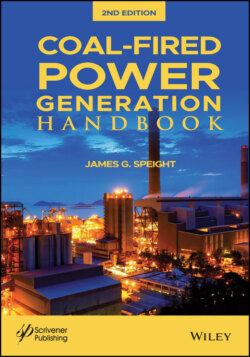Читать книгу Coal-Fired Power Generation Handbook - James Speight G., James G. Speight - Страница 68
3.5.2.1 Dense Media Washing
ОглавлениеThe dense media washing process (heavy media washing process) is the most popular method of cleaning coarse sizes and jig plants are probably the second most common method used for coarse coal.
In a heavy-media washing plant, all the cleaning is done by flotation in a medium of selected specific gravity, maintained by a dispersion of finely ground magnetite in water. The incoming raw coal is separated at 1/4 inch on an inclined screen. The oversize material (overs) proceeds to a flat pre-wet screen, where the fine dust particles are sprayed off from the +1/4-inch coal. This increment is discharged into a heavy-medium vessel or bath, where the refuse is separated from the coal. The refuse is discharged to a “refuse rinse” screen, where it is dewatered. The use of magnetite has also been investigated in cyclone cleaning of coal (Klima et al., 1990).
The freed medium is divided into two parts, one returning directly to circulation via the heavy-medium sump and the other pumped to magnetite recovery. The refuse is discharged from the screen for disposal. The coal is discharged from the washer to a coal-rinse screen, where the coal is dewatered and the medium is treated as from the refuse screen. The clean coal is then centrifuged, crushed, and loaded. The fine coal (less than 1/4 inch) from the raw coal screens is combined with magnetite and water and pumped to a heavy-media vessel in that the magnetite is finer and the effective specific gravity is different.
The refuse is dewatered and the medium is recovered, as in the coarse coal selection. The coal is discharged over a sieve bend and then proceeds to a centrifuge for final dewatering prior to transfer to a thermal dryer or to loading.
Sand processes employ suspensions, often unstable, of sand in liquids whose effectiveness can be maintained only by high rates of agitation and recirculation. Specific gravity separations up to 1.90 are obtainable, but specific gravities of 1.45 to 1.60 are more commonly employed for bituminous coals.
The most successful commercial application of this process has been the Chance sand process (Figure 3.3) which is one of the most widely adopted heavy-medium cleaning processes and consists of a large, inverted conical vessel in which sand is maintained in suspension in an upward current of water. The density of the fluid can be varied by increasing or decreasing the amount of sand held in suspension.
Figure 3.3 The chance sand flotation process (Speight, 2013).
Some heavy-medium flotation plants use finely crushed barium sulfate or magnetite in suspension in water. In some processes, termed dry, or pneumatic, cleaning air is used as the separating medium. Because densities are additive properties, the specific gravity of a suspension may be calculated from the concentration of solids in unit weight of suspension and the true density of the solids are known. However, the effective specific gravity of a suspension is strongly dependent on the stability of the suspension, which is, in turn, dependent on the fineness of the suspended particles.
